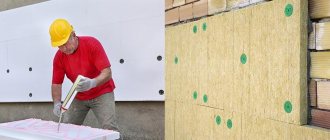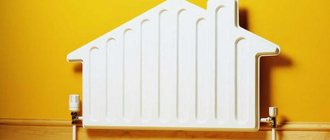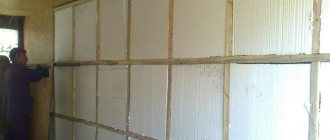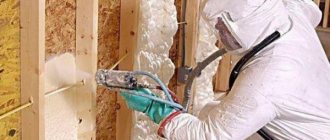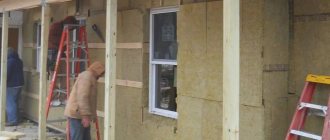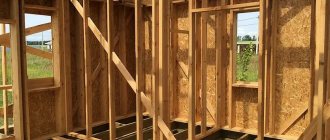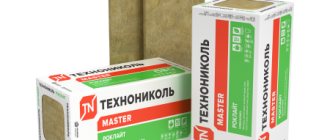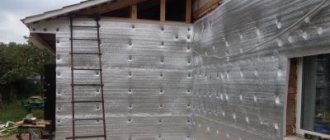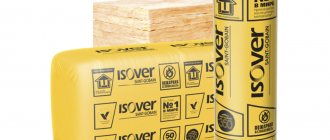A large number of natural insulation materials are presented on the domestic building materials market, so it is difficult to choose the optimal insulation material (in terms of quality and environmental friendliness) for thermal insulation of houses and various structures. It is because of this that the article will consider environmentally friendly insulation materials of all types.
Environmentally friendly insulation
Now in the Russian building materials market it is sometimes quite difficult to choose high-quality and safe insulation for thermal insulation of a house. This is due not so much to the technical parameters of the thermal insulation material, but to its safety parameters. It is necessary to choose the most environmentally friendly insulation, because it must not only insulate the house well, but also harm people’s health.
Below, the article discusses the most popular types of insulation materials today that meet all environmental standards established in our country.
Wool
This thermal insulation is made from sheep wool processed in a special way. The thickness of the canvas is 2-12 cm and has different densities. The material has a number of advantages:
- Absorbs up to 25% of its weight in moisture. This property allows you to regulate the level of humidity in the room. If the air becomes too dry, the wool will release water. Therefore, wool is laid without a vapor-permeable membrane.
- It is used for finishing partitions, walls, ceilings, and inter-rafter spaces. With the frame construction method, wool is placed between sheets of chipboard.
- Wool insulation is lightweight.
- Some wool insulation contains antiseptics that repel insects.
- Imported materials are treated with fire retardants.
The disadvantage of this insulation is the need for treatment with fire retardants and antiseptics. This reduces the positive environmental qualities of the material. Rodents live in wool.
People can be allergic to wool. Therefore, when the first signs of the development of the disease appear, it is necessary to remove the thermal insulation and redo the repairs. Otherwise, asthma may gradually develop.
Source material, structure
An environmentally friendly material for interior decoration and insulation of buildings is made from fibers of plant and animal origin.
It is mainly produced from:
- stems and seeds of plants;
- wood;
- wool
All the above materials are harmless to humans, this is how they differ from the usual glass wool, which can cause harm to human health. This is due to their crystalline structure, consisting of microparticles, pebbles, needles, etc. If these microparticles get into a person’s lungs, they will settle there forever and can cause various lung diseases (chronic bronchitis, silicosis, etc.).
These materials for interior decoration of buildings are highly flammable and very crumbly, so fire retardants (borax is often used for this purpose) and adhesives are added to the insulation.
Features of internal insulation of a house: what is important to know first
The main and hidden “enemy” of internal insulation is condensation. The air around us contains vapors in different concentrations. As a rule, in residential premises the concentration of vapors is often high. This is due to cooking in the kitchen, using bathrooms, watering flowerpots, wet cleaning and other reasons. Excess moisture is always removed through ventilation ducts and open windows. But in addition, they penetrate into the walls due to the porosity of the materials. When passing the wall, the vapor molecules necessarily collide with a conventional line, at which they turn into a liquid state - they condense. This line is called the "Dew Point".
With internal insulation, the dew point will always be located immediately behind the installed thermal insulation - that is, on the inner surface of the wall. When steam hits the wall, it forms condensation and moistens the wall material. The consequences of this are sad: immediately behind the insulation, a zone is formed with ideal conditions for the growth of bacteria, fungi, and mold. Thus, the premises may even become dangerous for living.
Based on what was described above, we conclude that the main task with internal insulation is to do everything possible to prevent contact of moist air with the dew point. That is, task No. 1 is to protect the inner surface of the wall from the slightest contact with steam . And this can be done quite simply. You need to do three things:
- follow the insulation installation technology;
- be sure to install a vapor barrier;
- choose the right material for wall insulation.
Main types of environmental insulation
Eco-friendly insulation materials can be either vegetable or cellulose.
The first include:
- linen;
- cotton;
- moss;
- hemp;
- other natural materials.
The insulation is made from the stems and seeds of plants, which are combined with a binder and treated with a fire retardant.
A characteristic feature of these materials is their fibrous structure, which creates high noise and thermal insulation in any room. In addition, this structure has good vapor permeability, so the walls will allow oxygen to pass through well.
When choosing environmentally friendly insulation, you need to take into account the fact that the quality of the insulation depends on the thermal insulation qualities of the material and the correct installation of the insulation. It is best to use slabs and mats that adhere well to almost all surfaces. Therefore, there will be no well-known “cold bridges”, and heat losses are reduced to a minimum. Thanks to this, they are indispensable in the thermal insulation of buildings.
Important! To achieve high-quality thermal insulation of buildings and structures, you need not only to choose the right insulation, but also to install it properly.
Peat blocks
Peat block is a natural, environmentally friendly insulation material for the home. Peat raw materials are ground with the addition of water, after which a filler is added to the resulting composition, which can be natural sawdust or shavings, straw, hemp or flax. The resulting mass is molded and dried until completely hardened.
The blocks are used to lay out the walls, floors, and sometimes ceilings of buildings. However, there are factors that can negatively affect the insulation - this is moisture. By accumulating water, the material changes its structure and quality characteristics.
The material is quite flammable and belongs to group G1.
No1. Hemp
Hemp has good antiseptic properties, which is why it does not rot or mold. Good strength makes hemp thermal insulation material (average 40 kg/m3) durable.
It is universal because it is suitable for thermal insulation of roofs, walls, floors, floors and frame structures. Moreover, its high price is paid off by good ventilation of the premises and a reduction in the cost of heating the house.
In terms of composition, the insulation consists of 85% fibers, 5% fire retardants (increases fire resistance), and 10% binders.
Main advantages:
- High thermal conductivity (up to 0.5 watt/m*K). It is stable at almost any humidity.
- High thermal inertia. Keeps the house warm in winter and cool in summer.
- Has high noise insulation properties.
- The material is harmless when disposed of.
- Easy to install.
- Adheres tightly to all surfaces.
The price of this material is about 1200 rubles. for 1m3.
Ecolen
One of the safest linen thermal insulation materials is eco-linen. The mass fraction of flax plant fibers in the insulation is 85%. The remaining 15 percent are thermal bonding fibers, thanks to which the insulation perfectly holds its shape and does not lose volume, which allows it to be used for insulating surfaces of complex shapes.
The material is produced in mats 5 or 10 centimeters thick. The heat transfer coefficient of ekoln is 0.034 W/m∙K. The insulation is quite breathable, therefore, with a laying density of 25-30 kg/m3, it provides sufficient breathing to the walls without allowing moisture to pass through. The service life should be 75 years.
No2. Linen
Insulation for walls made of flax has recently appeared on the domestic building materials market. It is used in public places (hospitals, kindergartens, schools, etc.), where great demands are placed on all materials.
The service life of linen insulation is 60 years, while the thermal insulation material retains its qualities throughout the entire period of operation. Fungus and mold do not form in it, and it does not burn, and in terms of thermal resistance parameters it is better than the glass wool we are used to. This makes it optimal for insulating buildings.
Stages of work
First of all, before insulating the walls of a house internally, it is important to know that the dew point will change - the place where moist air turns into condensation.
Consequently, if you choose the wrong material or its thickness, then such insulation can worsen the condition of the walls: mold, mildew, or destruction of the partition will appear.
It is important! In order to avoid irreparable mistakes, it is better to entrust all calculations for choosing insulation, as well as installation work, to specialists from a trusted construction company.
Before starting work on wall insulation, certain rules must be followed:
- Remove old coatings to the base of the surface, clean, remove possible formations of mold or mildew.
- Treat the wall with an antiseptic and primer solution. At the same time, give each coating a chance to dry.
- When using polystyrene foam, plaster the surfaces with the placement of beacons, which will allow for a more even plane. Allow to dry for at least two days.
- Laying the material.
- Finishing the wall.
No3. Cotton
The composition of this insulation consists of 85% cotton and 15% adhesive. Cotton insulation is produced in the form of mats. It has low thermal conductivity and high sound insulation, so it meets the requirements of any room with low humidity.
Advantages:
- It has high thermal insulation and noise insulation properties.
Flaws:
- Difficult to cut.
- Flammable It is required to include flame retardants (substances that prevent combustion) in its composition.
- Installation takes more time, unlike laying conventional mineral wool.
- A vapor barrier is required to protect the material from moisture.
Insulation of walls from the inside with polystyrene foam
Expanded polystyrene is objectively the most acceptable type of thermal insulation material for internal wall insulation. At the same time, only a special type of it should be used for internal thermal insulation - extruded polystyrene foam . The peculiarity of this building material is as follows:
- Increased density. Extruded polystyrene foam slabs are produced by the extrusion method - squeezing raw materials through a narrow nozzle of an extruder (special equipment) under pressure. The material forms a dense, airless structure and is characterized by increased strength, rigidity, and geometric accuracy.
- Almost zero vapor permeability. Installed as thermal insulation, XPS foam boards allow virtually no vapor to pass through them. Thus, this particular insulation is rational and suitable for internal thermal insulation. It becomes a natural barrier between the internal surfaces of the wall and the humid air in the room.
- Thermal insulation properties. Extruded polystyrene foam is characterized by an ultra-low thermal conductivity coefficient of about 0.037-0.041 W/m*K. It demonstrates excellent resistance to heat transfer, due to which the maximum insulation effect is achieved with a small thickness. At the same time, losses of useful volume from internal insulation are minimized.
- Low price. The material has an excellent cost-performance ratio.
Selection of extruded polystyrene foam for internal insulation
Extruded polystyrene foam boards differ in thickness and type of edge. For internal insulation, choose slabs with the following thickness:
- 2-3 cm for a small room area;
- 5 cm in large rooms;
- 10 cm when insulating a loggia balcony that is part of a living space.
The edge of the slabs is an important nuance that is always taken into account when choosing internal thermal insulation. Foam plastic slabs with a straight edge form a small gap when they meet, but still a gap. It is a natural bridge through which cold enters the room and vapor passes under the insulation.
For internal insulation, we recommend using only slabs with a locking joining system - L-edge . Due to this configuration, the thermal characteristics of the heat insulator are improved and vapor permeability is minimized.
Products suitable for internal insulation of houses and apartments include:
- TECHNONICOL CARBON ECO 1180x580x30 mm. Characterized by an optimal ratio of thickness and thermal insulation. Suitable for rooms with a small area, as it practically does not “eat up” square meters. Equipped with L-edge, has high heat transfer resistance.
- TECHNONICOL Technoplex 1180x580x50 mm. Equipped with excellent strength and thermal characteristics. It has an optimal thickness for insulating medium and large rooms and balconies.
- TECHNONICOL CARBON ECO 1180x580x100 mm. The most effective thermal insulation is achieved when installing such material. Equipped with an L-edge, it can be used for insulating open balconies and loggias, large rooms.
Installation of extruded polystyrene foam for internal insulation
Installation of this type of insulation is possible in two ways - using polystyrene foam glue or using dowels.
Dowel mounting:
- Fastening with dowels is carried out after preliminary arrangement of the vapor barrier. A metallized substrate, membrane or overlapping polyethylene film is installed on the wall.
- The seams are taped with aluminum tape to prevent steam from getting under the film.
- The slabs, pre-cut to size, are installed on the wall and fixed using plastic mushroom dowels with a plastic nail.
- The joints of the plates and the dowel heads are glued with aluminum foil.
- Finishing is carried out - plastering or cladding of gypsum boards.
Glue fastening:
- In this case, installing a vapor barrier is impossible, therefore, special attention is paid to the joints.
- You can use dry glue for polystyrene foam, for example, EK THERMEX or Yunis Teplomontazh. It is also permissible to use special glue in cylinders in the form of low-expansion foam.
- For better adhesion, the internal surfaces of the slabs are processed with a float until a rough surface is obtained.
- The glue can be applied evenly to the wall or in “bloops” on the slab along the edges and in the center.
- The plate is placed against the wall and pressed down. Flatness and level are checked at the same time.
- The joints are taped with aluminum tape.
- Finishing is in progress.
There is a combined method of fastening using glue and dowels. But it is rational for external insulation of a room. The foam inside will not experience increased stress. Therefore, it is enough to choose one of the options.
No4. Moss
Since ancient times, wooden houses have been insulated with moss, which protects the wood from rotting. Thanks to moss, it is possible to create a comfortable microclimate and good ventilation in the house. Today, heat-insulating materials based on moss are produced in small volumes. For example, it produces moss-based insulation “Flaxan MS50”. The manufacturing technology uses thermal bonding, and the thermal insulation material includes polyester fibers. As a result, mats measuring 60x10.5x5 cm are made.
This environmentally friendly home insulation costs 3,000 rubles. per pack (consists of sixteen mats).
Conclusion
Natural insulation materials based on natural fiber were presented to your attention. Manufacturers of these products position them as safe for use and environmentally friendly. When choosing a material, you need to start not only from the cost of insulation. Don’t forget that your home should be comfortable, cozy, and most importantly, safe for your health and the health of your children, family and friends.
By insulating the external walls and facade of the house, it would seem that one can neglect the requirements for environmental cleanliness and safety of thermal insulation. But the cracks and cracks that are opened to ventilate the window are all that allow direct access to all harmful and toxic substances into your home. Therefore, once you save on seemingly trifles, you risk having serious problems with your health.
Cellulose insulation (ecowool)
This is a highly air-conducting insulation consisting of 80% cellulose fiber, 12% antiseptic (most often boric acid), and 8% fire retardants.
There are 3 ways to lay ecowool:
- Manual. The material is loosened in containers using a mixer attachment and an electric drill (perforator). After which they fill cavities and niches in the required volume. The craftsmen have a special “pistol” in their arsenal for this purpose.
- Mechanized dry method. Everything is done as in the manual method, but for significant volumes of work, the material is blown into the voids with a compressor or gun. This significantly speeds up the work process.
- Mechanized wet laying. The thermal insulation material is loosened and moistened in the hopper of the blowing equipment, after which it is blown through nozzles to the desired location. Glue is added to the material as needed.
The advantages of Ecowool are:
- Zero waste. There is no material leftover as there is no need to cut it. Only the required volume of mixture is used.
- Seamless. The insulation is applied and laid in a single layer, so there are no seams, cold bridges, holes or cracks.
Cons of Ecowool:
- the manual method is very labor-intensive;
- The mechanized method requires expensive equipment and experienced specialists.
Important! The choice of thermal insulation material depends on the requirements that are presented in each specific case individually.
How to avoid negative consequences
The main task is to eliminate or minimize the formation of condensation in winter . To ensure this requirement, you must adhere to a number of rules:
- Select insulation with minimal vapor permeability. If this indicator is higher for the material of the walls of the house, then the moisture particles formed under the insulation will gradually come out.
- Mount the heat insulator close to the wall. With the adhesive method, the composition is applied in a continuous layer.
- Use a multilayer membrane and tape to seal joints when connecting insulation .
- Improve ventilation in the room - install forced hoods, install window valves.
- Calculate the thickness of the thermal insulation material. It is better to entrust this work to a construction engineer; you cannot rely on average indicators. The specialist will take into account all the characteristics of the house: type of building material, wall dimensions, climatic conditions of the region. It is better to take the thickness of the insulation with a small margin .
- Before installing the insulation, treat the wall with antibacterial and antifungal compounds. An antiseptic primer will do. The heat insulator is laid after the base has dried.
During the insulation process, it is important to exclude the appearance of cold bridges - they form at the joints of thermal insulation boards, as well as at the junctions of internal partitions and ceilings. The insulation must be placed with an overlap on the floor, ceiling and internal walls.
Flaws
All natural materials have the following disadvantages to a greater or lesser extent:
- Support combustion. To reduce the flammability rate, manufacturers add flame retardants to the composition, which can negatively affect health.
- Allergenicity. Almost all natural materials can cause various allergic reactions.
- Hygroscopicity. If there is high humidity in the room, the materials absorb moisture, become wet and cease to perform thermal insulation functions.
- They become a comfortable habitat for rodents and insects. To get rid of this deficiency, antiseptics are added to the composition, which are often unsafe for health.
In addition, it is difficult to calculate the thickness of the insulation that can be used to insulate a house. The density of materials may vary from manufacturer to manufacturer.
Whether or not to choose thermal insulation based on natural components to insulate your home is up to you to decide. Knowing the shortcomings of each material, you can take a number of actions to improve their performance.
Advantages of Ecoterm
- Excellent thermal insulation
. If we compare thermal conductivity coefficients, then a 5-centimeter Ecoterm layer is equal in thermal insulation qualities to 7 centimeters of cork insulation, approximately 25 centimeters of wood, 50 centimeters of foam concrete. - Highly environmentally friendly
. The material is made from flax fiber and has a small percentage of polymer impurities that are absolutely harmless to humans, animals and the environment. In addition, Ecoterm functions as a natural filter that helps clean the air, absorb odors and kill pathogenic microflora. - Ease of installation
. You can install Ecoterm yourself. The slabs have a convenient size and shape, they are pleasant to the touch. Plus they are quite lightweight. The material does not generate dust, does not prick, does not cause allergies and does not require the use of personal protective equipment. - Versatility
. Ecoterma slabs can be used for thermal insulation of residential, industrial and public buildings. They can be used to insulate walls, roofs, roofs, floors, interior partitions, and facades. Suitable for insulating timber houses and frame buildings. - Fast drying
. Linen gets wet, but dries quickly enough. At the same time, it does not lose its thermal insulation qualities. - The material does not shrink
. Ecoterm slabs are elastic and resistant to deformation. They do not sag or form voids over time. - Protects surfaces from condensation
. Due to its high vapor permeability, the material protects load-bearing structures from the destructive effects of condensation, as well as plaster and wood that are sensitive to humidity.
Ecoteplin
Ecoteplin belongs to linen eco-insulation materials. It consists of 100% flax fibers. Starch is used as a binder. Boron salt, or borax, which is already known to us, acts as a fire retardant. Synthetic additives are completely excluded from the material.
Thanks to its capillary structure, it absorbs moisture without letting it in and dries quickly, therefore it is used for insulating cottages, houses, steam rooms and saunas. It has reliable noise absorption and good sound insulation.
Foam glass - a successful tandem of components
To make foam glass as a thermal insulation material, a mixture of glass and foam is used, which makes it possible to create an elastic and porous insulator with a number of functional advantages.
The insulation is resistant to fire and high temperatures, waterproof, resistant to aggressive chemicals and durable.
Spray polyurethane foam
Cured polyurethane does not emit toxins, and insulates 1.5 times more effectively than glass wool (due to the absence of cracks and less frequent formation of condensation).
Harmful at work. When applying foam, harmful “chemicals” enter the air: an anti-aerosol respirator is required.
Crafty for structures. If used incorrectly, wood “sealed” with foam insulation will quickly rot.
Rapidly deteriorates when exposed to sun and moisture.
Flammable. Polyurethane foam burns a little worse than gasoline, and releases extremely toxic substances.
Damask
This material is made from seaweed. These are plants that are mined in the Black Sea. This type of thermal insulation contains a lot of sea salt, so the damask is practically not susceptible to the development of fungus in the structure. Algae is known for its high thermal insulation value. The disadvantage of the material is its fragility, so you need to be careful when installing it.
Advantages of the material:
- As humidity levels increase, the material absorbs water from the atmosphere. If the air is dry, the damask releases water into the surrounding space;
- Poor combustion support;
- Releases iodine into the environment, which is good for health;
- Rodents and insects do not nest in the insulation due to the presence of a large number of calcium compounds in the structure.
